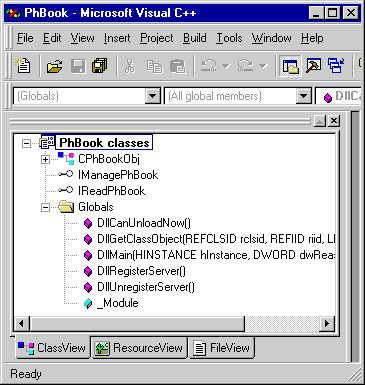| Lesson 6 | Examining ATL code |
| Objective | Understand object maps and COM maps. |
Examining ATL Code
Using Visual C++ tools to add class
CPhBookObj and interfaces IReadPhBook and IManagePhBook adds code and new files into our project. Class View should now show entries for both interfaces and CPhBookObj.

Adding COM object
PhBookObj to the project added an entry to the
object map in PhBook.cpp, our server implementation file.
Inside Object Maps
The ATL COM AppWizard created an empty object map in file PhBook.cpp, our server implementation file,
when we generated our project:
BEGIN_OBJECT_MAP(ObjectMap) END_OBJECT_MAP()
Adding class
CPhBookObj to implement COM object PhBookObj added an object entry to the map:
BEGIN_OBJECT_MAP(ObjectMap) OBJECT_ENTRY(CLSID_PhBookObj, CPhBookObj) END_OBJECT_MAP()
These macros generate a global array of structures of type
The
_ATL_OBJMAP_ENTRY called ObjectMap.
Each COM object implemented within the server plugs into the ATL framework via an _ATL_OBJMAP_ENTRY structure placed in the object map. The
_ATL_OBJMAP_ENTRY structure is used by the ATL framework code to create and access an object's class factory, create an instance of the C++ class (i.e., create an instance of the COM object), and get an object's CLSID.
BEGIN_OBJECT_MAP(ObjectMap) OBJECT_ENTRY(CLSID_PhBookObj, CPhBookObj) END_OBJECT_MAP()
Each COM object within a server is bound into the ATL framework by adding it into the object map using the OBJECT_ENTRY macro. The OBJECT_ENTRY macro takes the object's CLSID and the name of the implementation class as parameters. This identifies a specific C++ class as implementing a COM object.
Each COM object implementation class contains a COM map:
class CPhBookObj : ... {
...
BEGIN_COM_MAP(CPhBookObj)
COM_INTERFACE_ENTRY(IReadPhBook)
COM_INTERFACE_ENTRY(IManagePhBook)
END_COM_MAP()
...
};
Each interface implemented by an object has a COM_INTERFACE_ENTRY macro.
COM maps add methods and data into the class used by the ATL framework to manage each interface.
COM maps add methods and data into the class used by the ATL framework to manage each interface.
inside-com-maps.php
Inside COM Maps
Macro BEGIN_COM_MAP adds methods to cache a COM interface pointer (i.e., the next request for the pointer will use the cached pointer),
a method to get
Macro COM_INTERFACE_ENTRY places an interface and its IID into the interface map.
Macro END_COM_MAP delimits the end of the COM map.
Note: The implementation of these macros is slightly different in ATL 2.1 in Visual C++ 5.0 and ATL 3.0 in Visual C++ 6. This difference is not visible to applications developers.
ATL-based COM classes use multiple inheritance. Each class inherits from each interface it implements. Each of these interface classes is really an interface specification, for example, a class with all pure virtual methods. We previously discussed IUnknown (IUnknown is implemented in derived class CComObject), and an interface map within the class.
Macro COM_INTERFACE_ENTRY places an interface and its IID into the interface map.
Macro END_COM_MAP delimits the end of the COM map.
Note: The implementation of these macros is slightly different in ATL 2.1 in Visual C++ 5.0 and ATL 3.0 in Visual C++ 6. This difference is not visible to applications developers.
CComObjectRoot and CComCoClass. COM implementation class
CPhBookObj is defined in header file PhBookObj.h as follows:
class CPhBookObj :
public IReadPhBook,
public IManagePhBook,
public CComObjectRoot,
public CComCoClass <CPhBookObj,&CLSID_PhBookObj>
{
public:
CPhBookObj() {}
BEGIN_COM_MAP(CPhBookObj)
COM_INTERFACE_ENTRY(IReadPhBook)
COM_INTERFACE_ENTRY(IManagePhBook)
END_COM_MAP()
DECLARE_REGISTRY_RESOURCEID(IDR_PhBookObj)
public:
};
Macro DECLARE_REGISTRY_RESOURCEID will be discussed in the next lesson.
ATL COM Objects - Quiz
Click the Quiz link below to check your understanding of ATL COM objects.
ATL Com Objects - Quiz
ATL Com Objects - Quiz